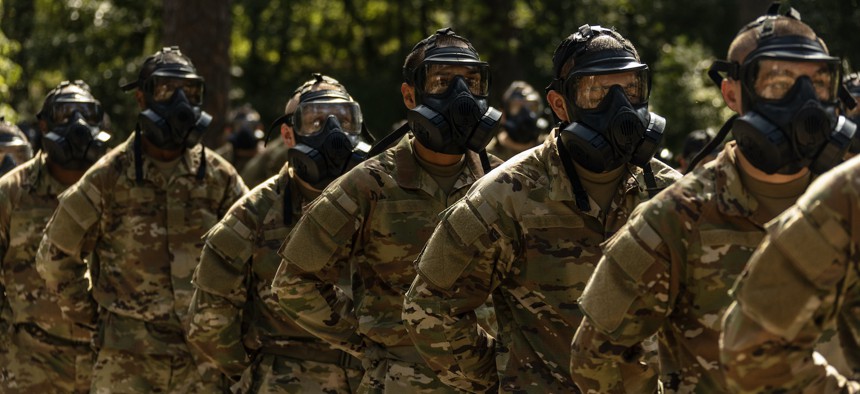
In this 2023 photo, Army recruits line up in gas masks during basic training at Fort Jackson, S.C. U.S. Army / Robin Hicks
Army recruiting on pace to hit goal—and break a years-long streak
Service secretary says new initiatives have put the 55,000-recruit goal within reach.
The Army is on track to break a years-long losing streak and hit its recruitment goal of 55,000 new soldiers this year, Army Secretary Christine Wormuth said during congressional testimony Tuesday.
“I don't want to get overly confident, but I think we're going to make our recruiting this year,” Wormuth said.
The Associated Press separately quoted Wormuth as saying the Army had recruited 5,000 more soldiers than it had the same time last year.
Wormuth cited the success of the Future Soldier Prep Course as one factor in the rise. The course, begun in August 2022, seeks to boost the physical fitness and academic scores of promising recruits who would otherwise fail to meet the Army’s requirements.
Other initiatives included rebooted Army advertising and changes to how the Army runs its recruitment offices, including the designation of recruiting as a specialized career. Army recruiters currently are pulled from other duties with little relevance to recruiting.
In January, Sergeant Major of the Army Michael Weimer told Congress that 14,700 recruits had graduated from the program over the year and a half it had existed.
The Army has struggled to sign adequate numbers of new recruits in recent years, amid what Wormuth has previously called the “most challenging recruitment environment in years.”
In 2022, the Army fell short of its goal by 25 percent, recruiting 45,000 out of a desired 60,000. In 2023, the Army recruited 54,000 soldiers, short of the 65,000 it wanted. Its 55,000 goal for this year is a steep decrease from last year’s goal of 65,000. The lower goal in part reflects changes to Army force structure that emphasizes air defense over close combat formations.
Army leaders, experts, and recruiters have offered a variety of explanations for the shortfall, such as a lack of access to high schools during COVID pandemic restrictions, the high rates of obesity and drug use among younger Americans, and even a new medical registration system.
In separate comments before the Congress on Tuesday, Wormuth addressed previous Army Times reporting that showed armored brigade combat teams sustained twice the number of suicides on average as other active duty forces.
Suicide rates are higher in general among armored, Stryker, and light infantry brigades, Wormuth said, citing Army data.
“I do worry about the [operational tempo] for those units,” Wormuth said, referring to balance between the time a unit is deployed and at home.
The Army is also lengthening the deployment schedule, stretching it from the current eight month deployed, eight month non-deployed time, Wormuth said.
“We found that in reality, they just can't move that fast,” Wormuth said. “So we're going to lengthen those windows to give them more time.”
She did not specify what specifically would change.
The Army had 160 suicides in the 2023 calender year among its active duty soldiers. The Army has around 445,000 active duty soldiers going into 2024. Suicide rates for active duty Army members have been between 100 and 180 per year since 2016, according to Defense Department data.




